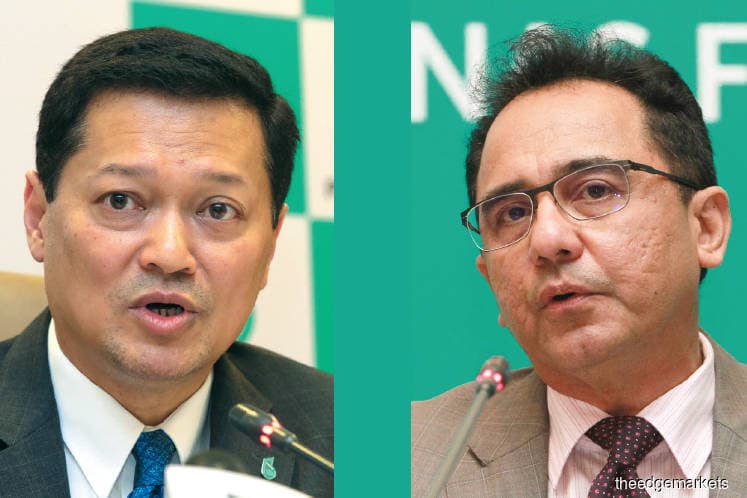
This article first appeared in The Edge Malaysia Weekly on September 3, 2018 - September 9, 2018
PETROLIAM Nasional Bhd is again getting more generous in declaring dividends, given that the federal government — its sole shareholder — needs to replenish the nation’s coffers. The national oil corporation announced that it would raise its dividend payment by 50% to RM24 billion this year, from RM16 billion in 2017.
The saving grace is that crude oil prices have been strong and seem to be sustainable above the US$60 level.
The RM24 billion dividend will be the highest since 2015, when the federal government received RM26 billion.
Announcing Petronas’ latest financial results last Friday, president and CEO Tan Sri Wan Zulkiflee Wan Ariffin says the oil firm is “in a better position to take advantage of better oil prices”.
In the first half, Brent crude averaged US$70.56 per barrel compared with US$51.80 per barrel in the same period last year.
However, Petronas spent less on capital expenditure although upstream activities have been picking up. Its capex for the first half declined 7% year on year to RM19.8 billion from RM21.3 billion a year ago.
In fact, the utilised capex — 66% of which was spent in Malaysia — is less than half of Petronas’ annual benchmark of RM50 billion.
For the whole of 2018, Wan Zulkiflee says the group’s capex should be about RM40 billion to RM50 billion.
About RM12 billion will go into upstream capex for Malaysia, says Petronas Upstream CEO Datuk Anuar Taib.
There is also good news for local upstream players. Anuar reveals that next year, local upstream capex may increase to “about RM14 billion to RM15 billion”.
“There will be more upstream exploration work to be done [here] … we will add a little bit more activities but in a very measured way.”
AmBank Research analyst Alex Goh comments that a decision by Petronas to refocus on exploration and production (E&P) would sit well with the government.
“Given the nation’s huge debt of RM1 trillion, we maintain our view that one of the government’s options to raise revenue will be to ramp up Petronas’ production against a backdrop of improving crude prices.
“This will mean a substantive refocus in spending for E&P activities despite Wan Zulkiflee earlier saying that the group will invest in downstream operations such as speciality chemicals and renewable energy solutions, including solar,” he says.
“Hence, we expect asset utilisation rates for local service companies to improve in the medium to longer term even though charter rates could remain unexciting in the light of excess capacity globally,” he writes in a research note after the release of Petronas’ second-quarter earnings.
For the second quarter ended June 30 (2QFY2018), Petronas more than doubled its net profit to RM11.56 billion from RM5.18 billion a year ago. Revenue expanded 14.7% to RM59.24 billion from RM51.63 billion in 2QFY2017.
Its net profit for the first half ended June 30 (1HFY2018) jumped 71.5% to RM22.96 billion from RM13.39 billion previously, thanks to ongoing internal efforts to optimise efficiency, higher average realised prices for all products and increased production.
“I am pleased to report that the result was achieved while keeping our operational costs stable, RM400 million less than the first half of 2017,” says Wan Zulkiflee.
Revenue grew at a slower rate of 8.33% to RM117.16 billion, from RM108.15 billion in 1HFY2017, as higher production and realised oil prices, combined with efforts to optimise efficiency, were hampered by the strengthening of the ringgit against the US dollar.
In 1HFY2018, the ringgit averaged 3.94 against the greenback, strengthening from an average of 4.39 in the same period last year.
Wan Zulkiflee points out that the group’s operations in the second half will be based on the expectation that Brent crude will average at “just below US$73” for the whole of 2018.
The national oil firm, however, expects the figure to decline to the US$50 to US$60 level next year, similar to its guidance in the 2018-2020 Petronas Activity Outlook.
Wan Zulkiflee also commented on Petronas’ investment in the LNG Canada project in Kitimat, British Columbia. He says the companies involved expect to finalise the final investment decision (FID) “in the next coming months”.
Petronas bought a 25% stake in the LNG Canada project in mid-2018. Its partners include Shell Canada Energy (40%); PetroChina Canada Ltd (15%); Diamond LNG Canada Ltd (15%), a subsidiary of Mitsubishi Corp; and Korea Gas Corp unit Kogas Canada LNG Ltd (5%).
The LNG project involves the design, construction and operation of a gas liquefaction plant and facilities for the storage and export of LNG, including marine facilities, with reports estimating it could cost C$40 billion (about RM123.9 billion).
On the ongoing state oil royalty issue, Wan Zulkiflee says Petronas will be guided by the federal government “whatever the final outcome will be”.
“We are leaving the discussion between the federal and the state governments. We will provide input and scenarios but we will not be involved in the discussion,” he explains.
Save by subscribing to us for your print and/or digital copy.
P/S: The Edge is also available on Apple's AppStore and Androids' Google Play.